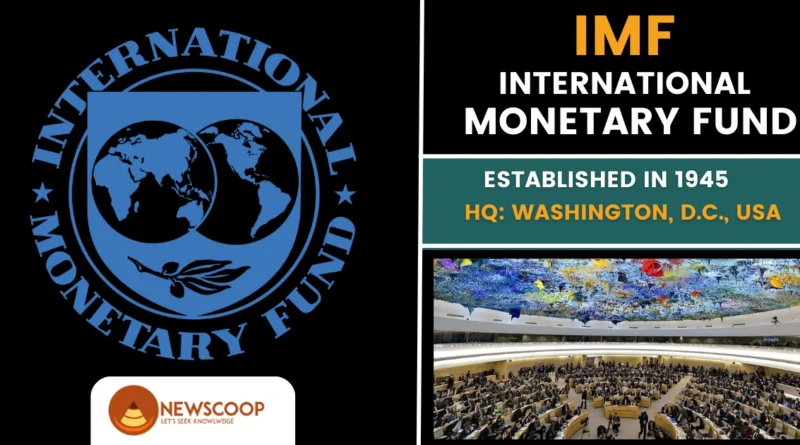International Monetary Fund (IMF): Functions & Objectives
International Monetary Fund (IMF) is a global financial institution established to promote international monetary cooperation, secure financial stability, facilitate international trade, and promote high employment, and sustainable economic growth.
In this article, we will discuss the IMF’s historical background, objectives of promoting economic stability and facilitating international trade, its structure and governance, and its relevance for UPSC aspirants in understanding global economic policies and current affairs.
What is International Monetary Fund (IMF)?
International Monetary Fund (IMF) is a global financial institution that was established in 1944. Initially, the International Monetary Fund (IMF) had 29 members, with India being one of the founding members. Its main goals are to promote international monetary cooperation, ensure financial stability, facilitate international trade, and foster sustainable economic growth. Moreover, it provides policy advice, and financial assistance, and monitors economies to help member countries address economic challenges and maintain stability.
How does the IMF different from the World Bank?
The IMF focuses on promoting global economic stability, addressing macroeconomic issues, and providing short-term financial assistance to member countries facing economic crises. The World Bank, on the other hand, focuses on long-term development and poverty reduction by providing financial support for infrastructure projects, education, healthcare, and social programs.
| Aspect | IMF | World Bank |
|---|---|---|
| Mandate and focus | Macroeconomic stability, exchange rates, and balance-of-payments issues | Long-term development and poverty reduction |
| Financing and lending | Provides primarily loans for balance-of-payment issues and economic stabilization | Provides loans and grants for development projects and social programs |
| Policy focus | Macroeconomic stability, fiscal discipline, monetary policies, and structural reforms | Poverty reduction, social development, infrastructure projects, and sustainable development |
Objectives of IMF
The following are the objectives of the IMF:
- Promoting international monetary cooperation.
- Ensuring financial stability.
- Facilitating international trade.
- Supporting sustainable economic growth.
- Providing policy advice and recommendations.
- Conducting economic surveillance.
- Assisting member countries facing economic challenges.
Headquarter of IMF
The International Monetary Fund (IMF) is headquartered in Washington, D.C., USA. The IMF complex consists of a main building and a temporary building. The main building was completed in 1998 and has 12 stories. It provides office space for the Managing Director, senior staff, and other professionals. In 2017, a temporary building was added to provide extra office space during renovations.
Establishment of the International Monetary Fund
The IMF was created during the Bretton Woods Conference held in 1944 in New Hampshire, United States. The conference aimed to design a new international financial system to prevent future economic crises. Representatives from 44 nations attended the conference and agreed to establish the IMF as one of the key institutions.
What is Bretton Woods Conference?
IMF & Balance of Payments (BOP)
The International Monetary Fund (IMF) plays a crucial role in addressing the balance of payments (BOP) issues faced by its member countries.
- Financial Assistance: The IMF provides financial support to member countries experiencing balance of payments (BOP) difficulties.
- Policy Advice: The IMF offers guidance and recommendations on economic policies to address BOP challenges and promote stability.
- External Balance: The IMF’s objective is to help member countries achieve external balance in their BOP positions.
- Sustainable Growth: The IMF aims to support sustainable economic growth while addressing BOP issues.
- Reforms and Adjustments: The IMF assists countries in implementing necessary economic reforms and policy adjustments to restore stability.
- Global Financial Stability: By working closely with member countries, the IMF contributes to global financial stability and crisis prevention.
What is the Balance of Payments (BOP)?
The Balance of Payments (BOP) is a record of all the economic transactions that occur between a country and other countries. It includes the buying and selling of goods and services, money transfers, and investments. The BOP helps us understand a country’s financial relationship with the rest of the world and whether it is receiving more money than it is spending or vice versa.
Special Drawing Right (SDR)
The Special Drawing Right (SDR) is an international reserve asset that was created by the International Monetary Fund (IMF). It is important to note that the SDR is not a currency itself, but rather a composite unit of value based on a basket of five major currencies:
- US dollar
- Euro
- Chinese renminbi
- Japanese yen
- British pound
The purpose of the SDR is to provide countries with an additional reserve asset that can supplement their existing reserves. It serves as a unit of account for international organizations and is based on a basket of currencies. The SDR is not a currency itself but can be exchanged for currency when required. It was created by the IMF to address the changing global financial landscape and provide stability in international monetary systems.
Value of SDR
The value of the Special Drawing Rights (SDR) in terms of the US dollar is determined daily using spot exchange rates observed at around noon London time. The International Monetary Fund (IMF) calculates and publishes the SDR value on its website.
Currently, 1 SDR is equal to 1.47 US Dollars.
India & IMF
India has a significant relationship with the International Monetary Fund (IMF) and actively participates in its activities. Here are key aspects of India’s engagement with the IMF:
- India is a founding member of the International Monetary Fund (IMF).
- Since 1993, India has not sought financial assistance from the IMF.
- The Finance Minister of India serves as an ex-officio Governor on the IMF’s Board of Governors.
- The Governor of the Reserve Bank of India (RBI) acts as the IMF’s Alternate Governor.
- Krishnamurthy Subramanian, former Chief Economic Adviser of India, was appointed as the Executive Director (India) at the IMF in November 2022.
- India’s current IMF quota is SDR 5,821.5 million, ranking 13th among quota-holding countries with a 2.44% stake.
- In terms of voting share, India (along with Bangladesh, Bhutan, and Sri Lanka) holds the 17th position out of 24 on the IMF’s Executive Board.
IMF’s Role in India
The International Monetary Fund (IMF) has played a significant role in India’s economic journey, particularly in addressing the balance of payments deficits and supporting the country’s development:
Financial Assistance in Challenging Times: Following the partition of India and during subsequent conflicts with Pakistan, India faced a severe balance of payments deficits. The IMF provided loans to help India overcome these financial difficulties and stabilize its economy.
Repayment of IMF Loans: India successfully repaid the loans it received from the IMF during the period from the establishment of the IMF until March 31, 1971. The loans were utilized to address various economic challenges, including the impact of conflicts.
Increased Assistance through Special Drawing Rights (SDRs): Since 1970, the IMF expanded the assistance available to member countries, including India, through the introduction of Special Drawing Rights (SDRs). These SDRs provided additional resources to address economic needs, such as rising import prices for essential commodities like food, fuel, and fertilizers.
Expertise and Independent Assessment: India has benefited from the IMF’s expertise by utilizing the services of IMF specialists to assess the state of the Indian economy. This independent scrutiny and advice have provided valuable insights and guidance for policy formulation and economic management.
Oil Facility and Special Fund: In response to the significant escalation of oil prices starting from October 1973, the IMF established a special fund to provide an oil facility. This initiative aimed to support countries, including India, grappling with the impact of rising oil prices on their balance of payments positions.
India’s Influence on IMF Policies: India holds a noteworthy position on the IMF’s Board of Directors, enabling the country to actively contribute to shaping IMF policies. This participation has enhanced India’s prestige in international circles and facilitated its engagement in determining global economic strategies.
Foreign Reserves and Liberalization: With the implementation of liberalization policies in 1991, India experienced an upturn in foreign reserves. This shift towards economic liberalization and reforms played a vital role in boosting India’s financial stability and resilience.
India’s collaboration with the IMF has provided crucial financial support, technical expertise, and policy guidance, contributing to the country’s economic growth and development. The IMF’s assistance has been instrumental in addressing the balance of payments challenges and strengthening India’s position in the global economic landscape.
Thank You!

